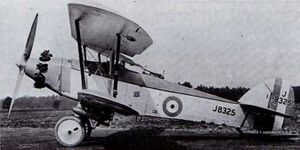Engineering:Hawker Harrier
| Harrier | |
|---|---|

| |
| Hawker Harrier prototype at A &AEE | |
| Role | Torpedo bomber |
| National origin | United Kingdom |
| Manufacturer | Hawker Aircraft Limited |
| Designer | Sydney Camm |
| First flight | February 1927 |
| Number built | 1 |
The Hawker Harrier was a British experimental biplane torpedo bomber aircraft built by Hawker Aircraft to a specification issued in the 1920s for the Royal Air Force .
Development
In 1925, the British Air Ministry laid down specifications for a high altitude bomber to replace the Hawker Horsley and for a coastal torpedo bomber (Specifications 23/25 and 24/25). As these specifications were similar, the Air Ministry announced that a single competition would be held to study aircraft submitted for both specifications.[1]
Sydney Camm of Hawker Aircraft designed the Harrier to meet the requirements of Specification 23/25, with the prototype (J8325) first flying in February 1927, the first of the competitors for the two specifications to fly.[1] The Harrier was a two-seat biplane with single-bay wings powered by a geared Bristol Jupiter VIII radial engine. It was armed with one .303 in (7.7 mm) Vickers machine gun and one .303 in (7.7 mm) Lewis gun carrying a maximum of 1,000 lb (450 kg) of bombs.[2]
The prototype Harrier was tested at the Aeroplane and Armament Experimental Establishment (A & AEE) at Martlesham Heath in November 1927, where, while it met the requirements of Specification 23/25 and had satisfactory handling, the geared engine meant that it was underpowered,[2] and it had an inferior bombload to the Hawker Horsley, the aircraft it was meant to replace.[1] It was therefore modified to carry a torpedo. On testing the modified aircraft, however, it was found to still be underpowered, being incapable of taking off with a torpedo, gunner and full fuel load.[1] It was therefore not considered further, the competition ultimately being won by the Vickers Vildebeest.[3]
The prototype was used by Bristol as an engine testbed, flying with the 870 hp (650 kW) Bristol Hydra and the 495 hp (369 kW) Bristol Orion engines.[1]
Specifications (Harrier, as bomber)
Data from Mason, The British Bomber since 1914 [1]
General characteristics
- Crew: two
- Length: 29 ft 7 in (9.02 m)
- Wingspan: 46 ft 3 in (14.10 m)
- Height: 13 ft 4 in (4.06 m)
- Wing area: 496.8 sq ft (46.15 m2)
- Empty weight: 3,278 lb (1,487 kg)
- Gross weight: 5,656 lb (2,566 kg)
- Fuel capacity: 191 imp gal (229 US gal; 870 L)[4]
- Powerplant: 1 × Bristol Jupiter VIII nine-cylinder geared radial engine, 583 hp (435 kW)
- Propellers: 2-bladed Watts wooden propeller, 12 ft 3 in (3.73 m) diameter [4]
Performance
- Maximum speed: 135 mph (217 km/h, 117 kn) at 6,500 ft (2,000 m)
- Service ceiling: 20,000 ft (6,100 m)
- Time to altitude: 18 min 30 s
Armament
- Guns: 1 × forward firing .303 in (7.7 mm) Vickers gun and 1 × .303 in (7.7 mm) Lewis gun on Scarff ring in rear cockpit
- Bombs: [4]
- 4× 250 lb (110 kg) GP bombs or
- 8× 112 lb (51 kg) bombs or
- 1× Type VIII 2,844 lb (1,290 kg) torpedo
See also
Aircraft of comparable role, configuration and era
References
Notes
- ↑ 1.0 1.1 1.2 1.3 1.4 1.5 Mason 1994, p. 193
- ↑ 2.0 2.1 Lewis 1980, p. 162
- ↑ Mason 1994, p. 200
- ↑ 4.0 4.1 4.2 Mason 1991, p. 148
Bibliography
- Lewis, Peter (1980). The British Bomber since 1914 (Third ed.). London: Putnam. ISBN 0-370-30265-6.
- Mason, Francis K. (1994). The British Bomber since 1914. London: Putnam Aeronautical Books. ISBN 0-85177-861-5.
- Mason, Francis K. (1991). Hawker Aircraft since 1920 (Third ed.). London: Putnam Aeronautical Books. ISBN 0-85177-839-9.
External links
- Hawker Harrier – British Aircraft Directory
 |

